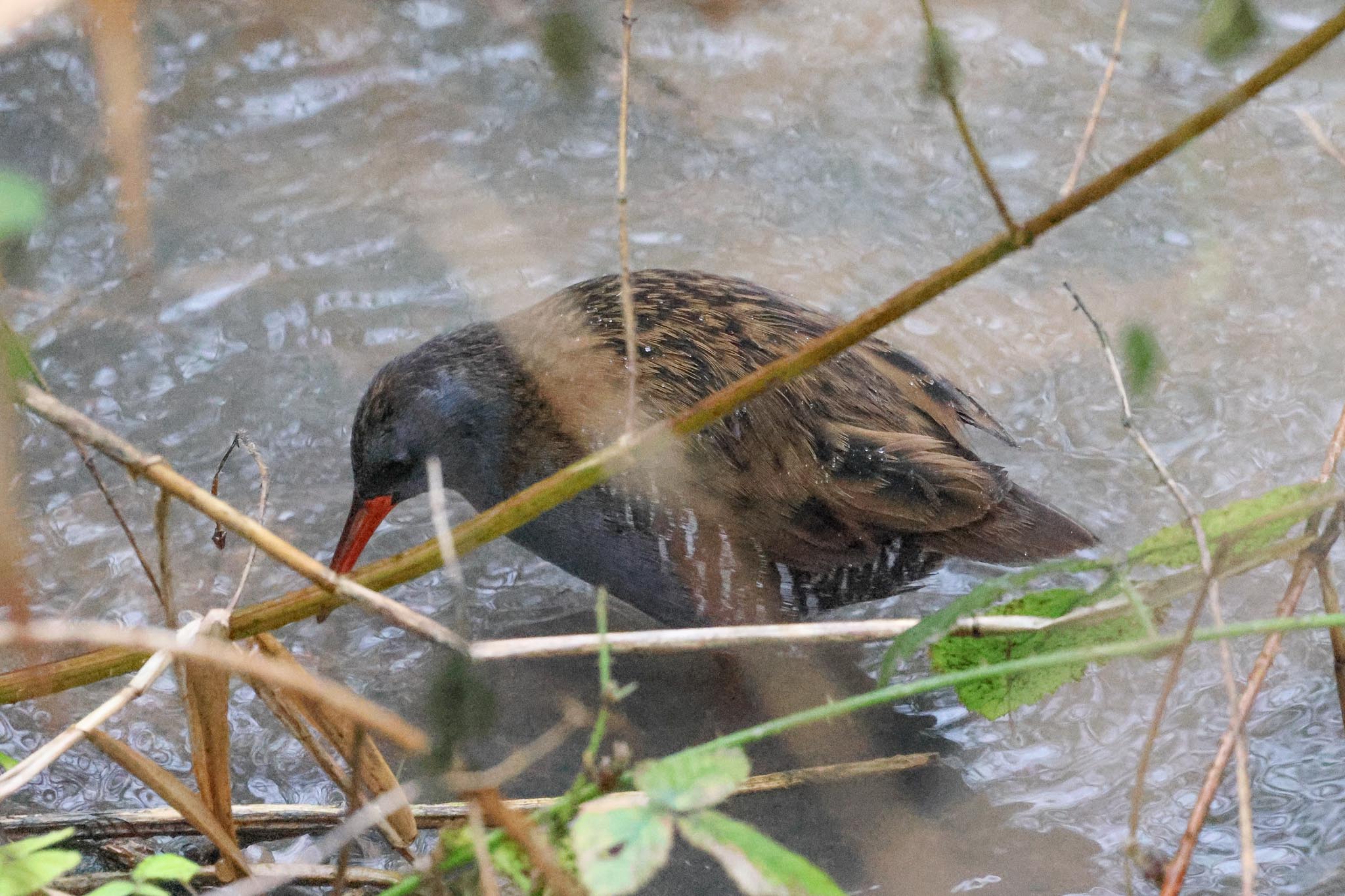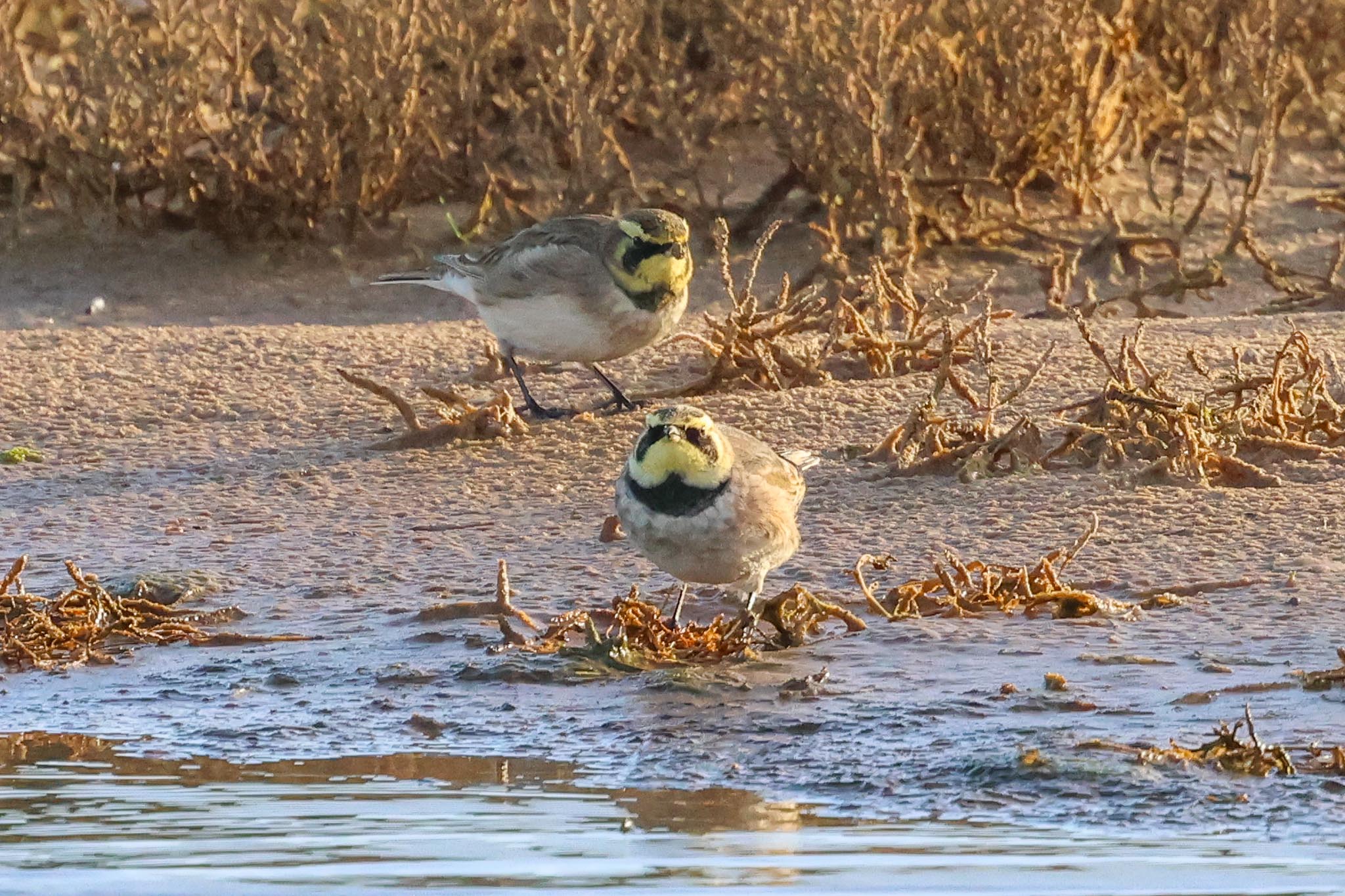A single day group tour in North Norfolk. The weather was challenging – it rained in the morning, though perhaps not quite as hard as had been forecast, and even though it cleared up early afternoon, it was increasingly windy. Still, we made the most of it and by the end, everyone agreed we had enjoyed a remarkably productive day.
It was already spitting with rain when we met and given the forecast, we decided to head for Titchwell first thing where we could make use of the hides. Very unusually, we were the only people in the car park when we arrived. As we walked down past the Visitor Centre, a charm of Goldfinches whirled around above us and disappeared into the alders. There were several Chaffinches along the start of the main path, as we walked along slowly, scanning the ditches. We quickly found what we were looking for – a Water Rail was picking around in the leaves on the edge of the water in the bottom of one of the ditches. Unconcerned by us standing on the path, looking down, we had some very nice views of this usually very secretive species.

There were just a few Mallard today on the reedbed pools and the nearby channels, so with thicker cloud now approaching from the south, we walked up to Island Hide where we could get some shelter. After the recent rains, the water levels are now very high right across the Freshmarsh, but we started to scan round to see what we could find. There was a nice selection of ducks, several on the island closest to the hide, which we got the scope on for a closer look – a pair of Gadwall, we admired the intricate plumage patterns on the drake, several Teal and more Mallard.
Feeding in between the ducks in the flooded vegetation were at least three Common Snipe, which were good to watch, probing their long bills vigorously into the wet mud. There was a Lapwing too, always nice to admire up close. Further back, over in the far compartment, we could see a flock of Dunlin feeding busily on one of the islands and a single Grey Plover in with them.

The rain was still light, so we took the opportunity to make our way round to Parrinder Hide without getting too wet. There were lots more ducks on the far compartment, mostly Teal but we did put the scope on a male Wigeon and a Shelduck which were both swimming round in the water between the islands. The Dunlin were still running around busily on one of the spits and while there was no sign of the Grey Plover with them, there were two Ringed Plovers with them now. A lone pair of Avocets were standing on the end of one of the islands further back – most of them have left us for the winter, gone south to find milder conditions, but always a handful of intrepid ones try to cling on.
The rain got heavier for a few minutes now, and when it eased a couple of Marsh Harriers came up out of the reedbed and chased round between the bushes. A grey male appeared briefly too – they were obviously not in any hurry to leave the roost today, and who could blame them!
A Curlew dropped in, in front of the other side of the hide, so we moved across to get the scope on it. It had a good bathe, flapping its wings in the water, and then stepped back to the edge of the island to preen. There were a couple of Redshanks on here as well, which we got the scope on too. After a while, when it had finished its ablutions, it flew off again, taking the Redshank with it. Two more Common Snipe were on the edge of the island now, and several Lapwing and the flock of Dunlin were further back.

There was just some misty drizzle now, but the wind had already picked up noticeably. We decided against walking out to the beach this morning, figuring it would be pretty unpleasant out there, so we made our way back out to the main path. The wind was in our faces, so we put our heads down and walked back quickly towards the shelter of the trees. The rain picked up again just as we got past the reedbed, so we hurried on to the Visitor Centre where it was nice to get into the warm, update the staff on what we had seen, and have a quick chance to check out the Christmas stock for those that wanted to.
As we walked back to the car park, the rain had eased off again and it had gone back to spitting. We boarded the minibus and decided to have a drive round to look for geese, so we could remain in the warm and avoid getting too wet again. Cutting inland, we drove round to a recently harvested sugar beet field. There were fewer geese here today than there have been in recent days, but there were still some nice groups of Pink-footed Geese and Greylags. We got out and got the scope on them – a good comparison between the two, the Pink-footed Geese noticeably smaller and darker headed, with a more delicate and mostly dark bill.

Looking across to the other side of the field and into the next one over, we could see that there were hundreds of Fieldfares and Starlings, feeding on the ground or up in the hedge. The Fieldfares are winter visitors here from Scandinavia, so we turned the scope on them for a closer look.
Moving on, we headed off to another area where we had been told a large flock of Brent Geese were feeding. There has been at least one Red-breasted Goose with the Brent Geese in Norfolk since November, but with the geese now feeding inland on winter wheat, they are hard to find and seldom seen. It doesn’t help that the flocks of Brents get moved on constantly by the local farmers. There were only a couple of small gaps where we could see through the hedge and the geese were nervous so we couldn’t get out, but we eventually all got a view of the Red-breasted Goose in with them.

It was time for lunch, so we dropped back down to the coast at Holkham. As we parked at Lady Anne’s Drive and got out, it had stopped raining completely now. There were lots of Wigeon, Teal and Shoveler out on the grazing marshes and a few Pink-footed Geese flying in and out of the fields further over. A Red Kite flew across behind us too. As we walked down towards The Lookout cafe, there were lots of Redshanks feeding in the now very wet grass just beyond the new (and annoying, as it spoils the view of the birds) bridlepath fence.

We ate in The Lookout – the group all bought hot drinks and were very kindly allowed to eat their sandwiches in the warm, as the wind had blown straight in through the slats and the tables outside the cafe enclosure were very wet. A lone Tufted Duck was on the pool beyond the cafe. While we were eating an unfamiliar yellow orb appeared in the sky – the sun showed itself through the clouds, which were starting to break up!
After lunch, we headed out towards the saltmarsh to look for the Shorelarks. They hadn’t been seen in the cordon this morning, and as we walked up towards the pines, another birder coming back said there was still no sign of them. A bit disappointing, but we figured we would walk out anyway now we were here – it was drying out a bit, and you never know. We scanned a couple of other places they have liked to get recently, but there was no sign, so we set off to walk down to the cordon.
Out beyond the Gap, we could see lots of black birds flying back and forth over the sea – lots of Common Scoter. Then looking behind us, we could see there were some very ominous dark clouds approaching over the pines – we had hoped we would remain dry now – and then the wind picked up significantly like it does when it is about to rain. We cut into the trees to get some shelter but thankfully the clouds blew quickly overhead and the sun came out again.
Back out onto the path along the edge of the saltmarsh by the start of the cordon, we began to scan across and quickly noticed a group of small birds on the sand over the far side, in front of the dunes. Getting the scope on them quickly, we could confirm our suspicions – they were the Shorelarks! We had a quick look from here, just in case they flew off, then walked out to the far side of the cordon and looked back. The Shorelarks were working their way towards us and with the sun now low in the sky behind us, their yellow faces shone in the late sunshine. We all had a good look, then when we took our eyes off them for a second to talk about them, they disappeared back into the saltmarsh.

We had a quick look at the sea, but the Scoter were now a long way out and with the wind still very blustery, the water was very choppy. We decided to make our way back and when we got back to Lady Anne’s Drive, there was a dramatic sunset over the park, the light shining between the clouds, flocks of Lapwings and Pink-footed Geese flying across in front. A couple of thousand Pink-footed Geese flew in and dropped down in the distance, the other side of Decoy Wood.
The light was already starting to go, but we figured we had time for one last stop, so we went for a quick look at the grazing marshes. We eventually found some White-fronted Geese, but they were distant, beyond Decoy Wood, and we could just make out their white fronts when they lifted their heads. There were a couple of Egyptian Geese on the grass a bit closer. We found a Great White Egret too and had a nice view when it came up out of the pool where it had been feeding.

There were already lots of Cormorants in the trees, and then a couple of huge flocks of Jackdaws flew out and landing in the trees in the wood to roost – an impressive sight in the scope. A couple of Common Buzzards flew past and up into the park – time for bed for them too. It was around the time for the Pink-footed Geese to come in to roost, so we waited to see when they would arrive. They were 5-10 minutes later than usual today, and most came in from the east, still impressive to watch as several thousand filled the sky and then whiffled down onto the grazing marshes.
A nice way to end the day, it was time to head back.
















